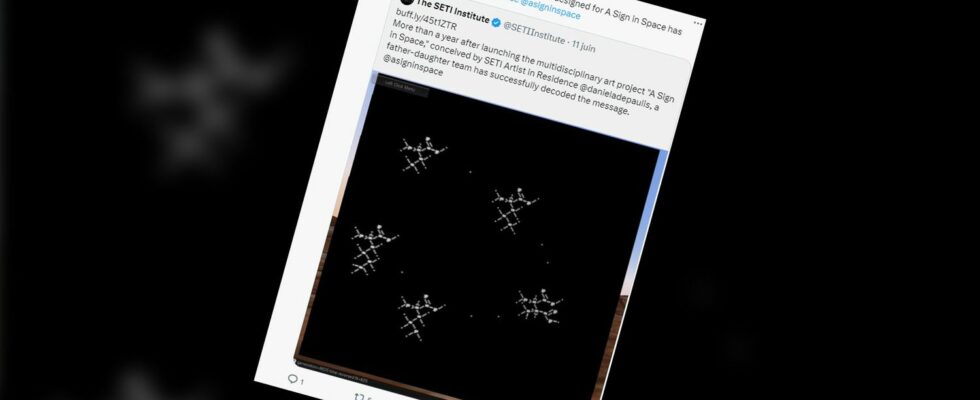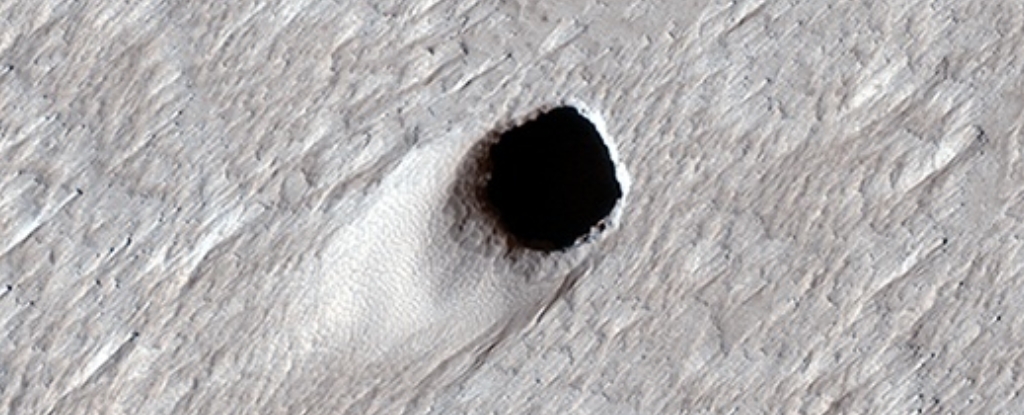
SETI Institute In the News
The SETI Institute frequently appears in news stories due to its essential contributions to space science and exploration.
Join us as we delve into the mysteries of holes on Mars, witness the transformative impact of NVIDIA's AI technology on radio astronomy, and uncover new insights into celestial phenomena with the James Webb Space Telescope.

Simulated 'Alien Message' Decoded After One Year
In May 2023, Daniela De Paulis, SETI Institute Artist in Residence, launched her “A Sign in Space” project and led an international team to send an encoded message from the European Space Agency that we might receive from an advanced extraterrestrial civilization. The message intrigued the global community, garnering widespread media coverage and over a million downloads in an attempt to decode it. In just over a year, a father and daughter successfully deciphered the message using a mathematical model known as a cellular automaton. While a feat in itself, its deeper significance still remains unclear, prompting further speculation and engagement among the community eager to uncover its meaning.
Read the full article by Actual News Magazine here: A Father and His Daughter Succeed in Decoding a Message Sent From Space

What Mysterious Holes on Mars Could Mean
A recently resurfaced image of pits on Mars has ignited a conversation among scientists about what they could represent. Ross Beyer, a planetary scientist at the SETI Institute, theorizes that these pits could lead to larger caves or they could simply be isolated pits. The question at the top of everyone’s mind is: could they be warm enough inside for life to arise? Maybe. But as Beyer puts it: "There's no way to know what's in them until we explore them in more detail."
Read the full article by Science Alert here: Mysterious Holes on Mars Could Hold Secrets to Extraterrestrial Life
How Nvidia Technology is Advancing Radio Astronomy
NVIDIA has launched NVIDIA AI Enterprise-IGX with Holoscan on the NVIDIA IGX platform, enabling real-time AI applications in healthcare, industry, and scientific fields at the edge. SETI Institute utilizes NVIDIA IGX Orin to enhance radio astronomy capabilities at the Hat Creek Radio Observatory, the only radio telescope built from the ground up to conduct the search for the technologically-capable extraterrestrial life. With the NVIDIA IGX Orin platform, scientists can now “stream multiple terabits per second of radio telescope data directly into AI classifiers,” said Andrew Siemion, Bernard M. Oliver Chair at SETI Institute, “allowing us to process more bandwidth from more antennas to detect weaker and rarer astrophysical phenomena.”
Read the full article by Global News Wire here: NVIDIA Enables Real-Time Healthcare, Industrial and Scientific AI Applications at the Edge With Enterprise Software Support for NVIDIA IGX With Holoscan

New SETI Institute Grants Program for Technosignature Science
The SETI Institute has launched a pioneering grants program aimed at advancing technosignature science, utilizing the capabilities of the Allen Telescope Array to explore potential signs of extraterrestrial technology. This initiative marks a significant step forward in supporting innovative research across observational, theoretical, and technical domains within the field of technosignature science.
Read the full article by Sci Tech Daily here: https://scitechdaily.com/chasing-cosmic-clues-groundbreaking-new-seti-grants-could-shape-the-search-for-alien-technology/

James Webb Telescope Reveals New Finding About Well-Known Nebula
Previously thought to be a single star, the James Webb Space Telescope (JWST) MIRI recently revealed the Rho Ophiuchi nebula as a pair of young stars emitting jets of hot gas. This discovery, presented at the American Astronomical Society's 244th meeting, underscores the JWST’s capability in advanced infrared optics, crucial for studying dusty nebulae where visible light is obscured. SETI Institute astronomer, Mary Barsony, noted the revelation's significance: “Our jaws dropped. After studying this source for decades, we thought we knew it pretty well. But we would not have known these were two stars or that these jets existed without MIRI. That’s really astonishing. It’s like having brand new eyes.”
Read the full article by Before It’s News here: Matched Twin Stars are Firing Their Jets Into Space Together





